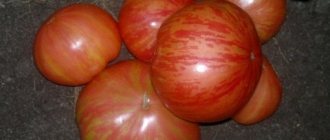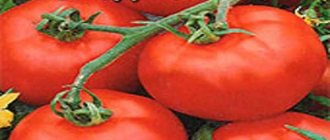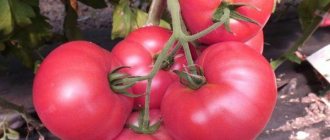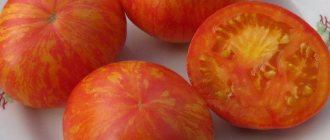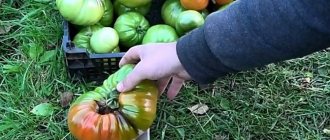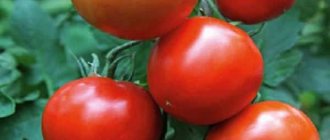Tomato Bolivar from breeder L.A. Myazina is a hybrid obtained by the classical method of selection (hand pollination). Bolivar is part of the group of large-fruited tomatoes for open ground. During the work, certain goals were pursued:
- increasing resistance to diseases and bad weather conditions;
- improved taste;
- large fruits;
- early maturation;
- productivity.
The early ripening of the hybrid allows it to be grown in areas with short summers.
Description
The description of large-fruited tomatoes Bolivar F1 meets the wishes of most tomato lovers. The hybrid for open ground is characterized by high productivity - 4 kg of fruit per bush, which is 1.5 times higher than the productivity of older hybrids.
New generation tomatoes contain more useful elements than older varieties. Summer residents will appreciate the following valuable features:
- presentation of the fruit;
- transportability of tomatoes;
- excellent pickling qualities of tomatoes.
Bolivar F1 tomatoes are planted according to the 60*60 cm pattern. When placed on 1 sq. m. 2 bushes get maximum yield.
The fruits are large, red, tasty with fleshy pulp, and ripen 80 days after germination. The declared fruit weight is 200–250 g. Due to early ripening, the bushes do not suffer from late blight. The fruits of the Bolivar tomato are universal; their uses in cooking are varied.
Reviews
The first generation hybrid Bolivar F1 was bred not so long ago, but on the Internet it is easy to find reviews of summer residents who grew it. Opinions vary, but mostly positive. Summer residents discuss more about bush formation schemes and the need for pinching. Opinions differ on these issues. Some believe that there is no need for stepsons, others prefer to form 3-4 stems and remove excess stepsons.
See also
Characteristics and description of the tomato variety Miracle of the World, its yieldRead
Plant new Bolivar F1 super tomatoes at your dacha, share your impressions of the quality and quantity of tomatoes grown.
Sowing time
We calculate the sowing time as follows. The reference point is the approximate date of planting in the ground; from it you need to subtract the sum of days:
- the age of seedlings ready for transplanting is 45–55 days;
- 7 days for seed germination;
- 5 days to adapt after the pick.
In regions with short summers, there should be a bud on the second cluster before planting in the ground. In this case, all the fruits will ripen.
In order to get strong, healthy seedlings of early-ripening tomatoes by June 10, seeds for seedlings must be sown from April 1 to April 10. Having planted seedlings with buds during this time, the first tomatoes are harvested in open ground in mid-July.
See also
Description of the Soviet tomato variety and its characteristicsRead
About sowing seeds
Treat the seeds before sowing. First, place them in a weak solution of potassium permanganate for 20 minutes. To prepare it, 1 g of manganese crystals is dissolved in a partial glass of water. The next stage of processing is soaking the tomato seeds in any hormonal preparation:
- Agat-25.
- Immunocytophyte.
- Epin-Extra.
- Zircon.
Growth stimulants help accelerate seed germination, increase their immunity and stress resistance of tomatoes. Sow the seeds in the ground the next day, without waiting for them to hatch.
Sow the seeds to a depth of 2 cm. Compact the soil, then the sprout, breaking through the dense layer of soil, will throw off the flaps from the seed. To ensure friendly seedlings, always cover the box with seeds tightly with film.
Tomato seedlings absorb nutrients from the soil well at night temperatures of 14 °C and daytime temperatures of 16 °C. Under optimal conditions, tomato seedlings form good roots and produce more flowers.
Higher temperatures provoke excessive growth of stems in seedlings, weakening of roots and fewer flowers.
Review: Seeds Gardens of Russia “Tomato Bolivar F1” – They sprouted, grew and started.
Good afternoon, dear friends and readers of the Otzovik website!
I continue the series of reviews about seeds ordered for the first time from the Gardens of Russia online store. Today I will share my impressions of the super tomato seeds “Bolivar F1”.
The seeds were sown in boxes on March 15, then they were picked. I planted tomatoes in the greenhouse on April 23, in open ground somewhere around May 7-9.
This variety of tomato is intended for planting in open ground, but I decided to try planting two roots in a greenhouse. The packaging states that from germination to fruiting 85-95 days. I assumed that in the greenhouse they would ripen earlier, especially since we have not closed the greenhouse at all since the end of May - the nights were very warm. That is, there is air movement in it around the clock.
As always, “Gardens of Russia” has a very nice package with seeds.
On the back of the package are recommendations for landing distances. Information about the height of the bush, ripening time, fruit weight. The manufacturer promises us fourteen to fifteen kilograms per square meter.
Inside the package is another paper bag containing seeds. There should have been fifteen seeds in the bag. I had another seed as a gift)).
The seeds sprouted together, I can’t say for sure whether all sixteen seeds sprouted, but there were no “bald spots” in the box. I think that even if it didn’t sprout, only two or three seeds at most.
The bushes grew not tall, but I would say powerful. The tomatoes started well, even in the greenhouse. Considering that the cost of fifteen seeds is thirty-five rubles, the result is not bad. It's less on the street for now. The fruits are slowly starting to lighten, I hope that they will soon begin to turn brown.
But I didn’t receive any fruit after the stated 85-95 days. If we take into account that the shoots were on March 20, then right now we should be eating our tomatoes to the fullest, but no - we don’t eat them, we’re just licking our lips for now)).
In this regard, I can conclude that the company writes the ripening dates incorrectly. It was the same story with these delicious cucumbers, on the packaging of which it was indicated 51 days before ripening, and I picked the first cucumber on the 37th day.
I have no doubt about the taste properties of tomatoes; I adore any variety, they are all delicious to me. Therefore, I will not wait for the fruit to ripen to write a review.
I can already conclude that I liked the Bolivar F1 tomato variety. The seeds have good germination and germinate perfectly even in a greenhouse, although they do not seem to be intended for growing in one. The fruits are not small. True, I removed the stepchildren.
Perhaps if I left all the stepsons, the tomatoes would be smaller. I don’t like wild thickets; at first I pinch off almost everything. Then they themselves no longer grow as much as in May-June.
I'm taking note of this variety for purchase next year. And I recommend you try it.
The effect of irrigation on the taste of tomatoes and the quality of seedlings
You cannot place boxes with seedlings on cold window sills, so that the soil does not overcool, you need to put any insulating material under them. Do not moisten the soil too much; the seeds will not have enough oxygen. For watering, use only warm water.
The agronomist believes that the quality of irrigation affects the taste of ripe tomatoes. In temperate climates, watering and loosening tomatoes in open ground should be completed when the fruits on the bushes begin to ripen. After harvesting ripened fruits, watering can be resumed.
In the garden
Growing tomatoes in open ground
Our article on growing tomatoes in open ground is based on the experience of growing the Bolivar tomato variety, a tall tomato intended for greenhouses, film tunnels and open ground. Let's look at the results for this tomato variety in comparison with the Santa Cruz variety. When growing tomato seedlings and caring for the plants, no special conditions were created; our tomato bush grew in the same bed with its rivals Santa Cruz and De Barao. The region where we conducted this experiment in growing tomatoes is the Voronezh region.
We planted Bolivar, Santa Cruz and De Barao tomatoes on May 10, the plants developed normally, all three varieties gained strength equally. When the ovary began to appear, the heat began, the thermometer in the sun went off scale at 45 degrees and above. All hope was for watering. The “law of meanness” immediately comes into play: the water tower turned out to be unable to provide our experimental garden with sufficient water - enough for living, but not enough for watering. Two little rains helped. We survived.
Initially, we considered Bolivar tomatoes to be the same ordinary variety as other tall varieties of tomatoes. When saving the plants from the heat, they noticed that Bolivar needed more water than the others. Accordingly, the grooves around the bushes were deepened and the tomatoes were watered abundantly. We fed it twice with chicken droppings, tied it up as the bush grew, and by mid-July it became clear that there was a truly “royal” tomato in the beds. Why?
First of all, the indescribable beauty of the tomato bush itself: height up to 2-2.5 m, with numerous stepsons, additional stems and dense green foliage. At a height of 1.5-2 meters hang brushes, on which almost every tomato weighs up to 300 grams. The annotation for the Bolivar variety says that the weight of each fruit is 120 grams. This is an average, but in our case individual specimens on the lower hands weighed 250-300 g. And such kilogram hands “hover” above the ground at a decent height - a miracle, right? I didn’t want to tear them off quickly, but rather admire and admire them longer...
The control Bolivar tomato bush was grown in open ground without pinching, the growing point on it was not pinched, the lower leaves were not torn off, but it was securely tied up. So, this bush yielded a harvest of 22 kilograms of tomatoes, which would still grow and grow, but on September 29 the frost hit minus three... We have no doubt that if our tomatoes were grown not in open ground, but in a greenhouse, the fruits would grow would ripen until January. Which varieties should it be classified according to ripening time? To be fair - none. It is “long-lasting”: it begins to ripen with early varieties and continues indefinitely until frost strikes.
Usually, by late autumn, after long-term storage, the taste of tomatoes changes; they become lethargic, dried out, or, conversely, softened. The same cannot be said about Bolivar tomatoes: they are perfectly preserved, do not rot, and do not turn black. Once picked, tomatoes of this variety react in a special way to temperature conditions. They lie at a temperature of 10-15 degrees for almost two months and remain as if they had just been brought from the garden. And then they ripen “according to requests”: once you put them in a warm place, the tomatoes will ripen within a day. When other tomatoes have to wait a week or two until they turn red in the warmth, Bolivar “obediently” turns red almost as soon as it is required of him. Ripening in beds from the beginning of July until frost, Bolivar ripens in boxes from early autumn to infinity, incredibly surprising with this regime. In terms of ripening and keeping quality, it has no equal.
Resistance to late blight. The summer was dry, so late blight should not have occurred. But on August 6, a strong cold fog descended, and the next morning - “Hello, I am your late blight!” True, she turned out to be not evil, she did not touch the fruits, and the leaves dried out on all varieties except Bolivar and Santa Cruz. The bushes were green, which means that Bolivar is resistant to late blight.
Growing tomatoes
1. Bush without pinching with obligatory garter (the results have already been mentioned).
2. When forming a bush of 1-4 stems with pinching the growing point, removing the lower leaves, and rigid tying, the yield was: on a single-stem bush - 3.4 kg, on a two-stem bush - 5.1 kg, on a three-stem bush - 7.2 kg, on four-stem bush - 8.0 kg of tomatoes. After removing the shoots and extra stems, the plants looked depressed and lifeless. Burns appeared on the bare bushes, especially on the upper brushes. By mid-August, life in them had come to a standstill. 3. Bush without pinching and without garter (in a lying position). Productivity 10.6 kg. The fruits ripened longer, there were fewer burns; With the beginning of the rains, slugs appeared on the fruits, and some tomatoes turned black. If a “standing” bush without pinching brings joy and satisfaction to the gardener, then a “lying” one causes “moral damage.” You look at him and think: “Why did they offend you, poor thing?” Bolivar made me understand that pinching depresses the plant, leads to loss of yield and a reduction in the vital activity of the bush. Therefore, I will tell the stepson “stop” - there is no need to injure the plant, disturb it, or make it feel bad.
Bolivar tomatoes
Based on the results of growing our tomatoes, we will draw some conclusions about this tomato variety.
Landing
It is important to adhere to a number of rules so that the variety is planted according to all the rules. It is important that the air temperature is within 22... 25°C
If the temperature drops below 10°C, the pollen in the flowers will not ripen. This, in turn, will cause the ovary to fall off.
Growing seedlings
It includes several basic techniques. These include:
- Sowing. Seeds are sown in trays with moistened soil to a depth of 1.5-2 cm. Sprinkle with substrate on top, moisten and cover with film. The containers are placed in a bright place. Shoots can be obtained as early as 10-11 days at a room temperature of at least 20-25 °C.
- Pick. At the stage of development of two true leaves, plants are picked by planting in individual containers, cassettes or special nurseries.
15-18 days after picking, young plants are planted in a permanent place. By this time, the tomatoes have a well-developed root system, 7-8 true leaves, a strong stem and a slightly noticeable brush.
The bushes are planted in pre-prepared holes at a distance of 30-35 cm from each other. The row spacing should be at least 80-90 cm. This arrangement contributes to optimal and uniform distribution of light.
Medium varieties of tomatoes for open ground
Among the average ripening varieties of tomatoes for open ground, 4 of the best can be distinguished:
- Scarlet Candles (2007),
- Mushroom basket (2008),
- Favorite holiday (2008),
- Intuition (1998).
However, when considering varieties by ripening time, it is always worth remembering that weather can greatly influence the length of the period from germination to fruit appearance.
Scarlet candles
The variety first appeared on the shelves of seed stores in 2007. It is both a salad and pickling variety. Scarlet candles form a cylindrical fruit, completely smooth and quite dense. The color of the ripe fruit is pink with 2-3 nests. The average fruit weight is about 50 g, but it can be more. The taste is almost perfect. From 1 m² you can harvest up to 12.2 kg of tomatoes.
Mushroom basket is also a salad variety that produces flat-round fruits, with clearly visible ribs and medium density. The color of ripe fruits is pink, and the number of nests can reach 6. The weight of each fruit often exceeds 200 g, the taste is wonderful, the yield is just over 6 kg of fruit per 1 m².
Favorite holiday
It is distinguished by its heart-shaped fruit, slight ribbing and medium-thick skin. The ripe fruit is pink in color, the number of nests can vary up to 6 pieces, and sometimes more. The weight of fruits on good and nutritious soil exceeds 300 g. The taste of the variety is excellent, the yield per 1 m² is just over 7 kg.
Characteristics
“Krasnobay” is a hybrid variety bred in Russia; it received state registration as a hybrid for growing in greenhouses in 2008. Since then it has gained well-deserved popularity for its high varietal qualities. Since this hybrid variety is intended primarily for greenhouses of various types, the region for cultivation is not particularly important.
Of course, if we are talking about film shelters, then the southern regions are better suited for this. Greenhouses with glass covering and heating are suitable for any region, even the northern region. If you try to grow this variety in open ground, then only the southern regions are suitable for this, since in other places they will not have time to ripen.
These fruits have excellent taste and are very good in salads and fresh. They are very suitable for barrel pickling; they are not suitable for whole-fruit canning due to their size. Thanks to the ideal combination of sugars and acids and low dry matter content, these tomatoes produce excellent juice.
This variety has a truly record yield. With proper care, you can get up to 12-14 kg from one bush. With a planting scheme of 3 bushes per square meter. m, and this is the recommended scheme, you can get about 30 kg. This is a very high figure.
You can compare the yield of this variety with others in the table below:
| Variety name | Productivity |
| Krasnobay | up to 30 kg per square meter |
| Peter the First | 3.5-4.5 kg per bush |
| Pink flamingo | 2.3-3.5 kg per square meter |
| Tsar Peter | 2.5 kg per bush |
| Alpatieva 905A | 2 kg per bush |
| f1 favorite | 19-20 kg per square meter |
| La la fa | 20 kg per square meter |
| Right size | 12-13 kg per square meter |
| Dimensionless | 6-7.5 kg per bush |
| Nikola | 8 kg per square meter |
| Demidov | 1.5-4.7 kg per bush |
Among the main advantages of this hybrid variety are:
- disease resistance;
- beautiful appearance;
- very high yield;
- good taste.
Disadvantages include late yield and the fact that these tomatoes do not have time to ripen in open ground, so they are recommended only for greenhouses.
On our website you will find a lot of useful information about growing tomatoes. Read all about indeterminate and determinate varieties.
And also about the intricacies of caring for early ripening varieties and varieties characterized by high productivity and disease resistance.
